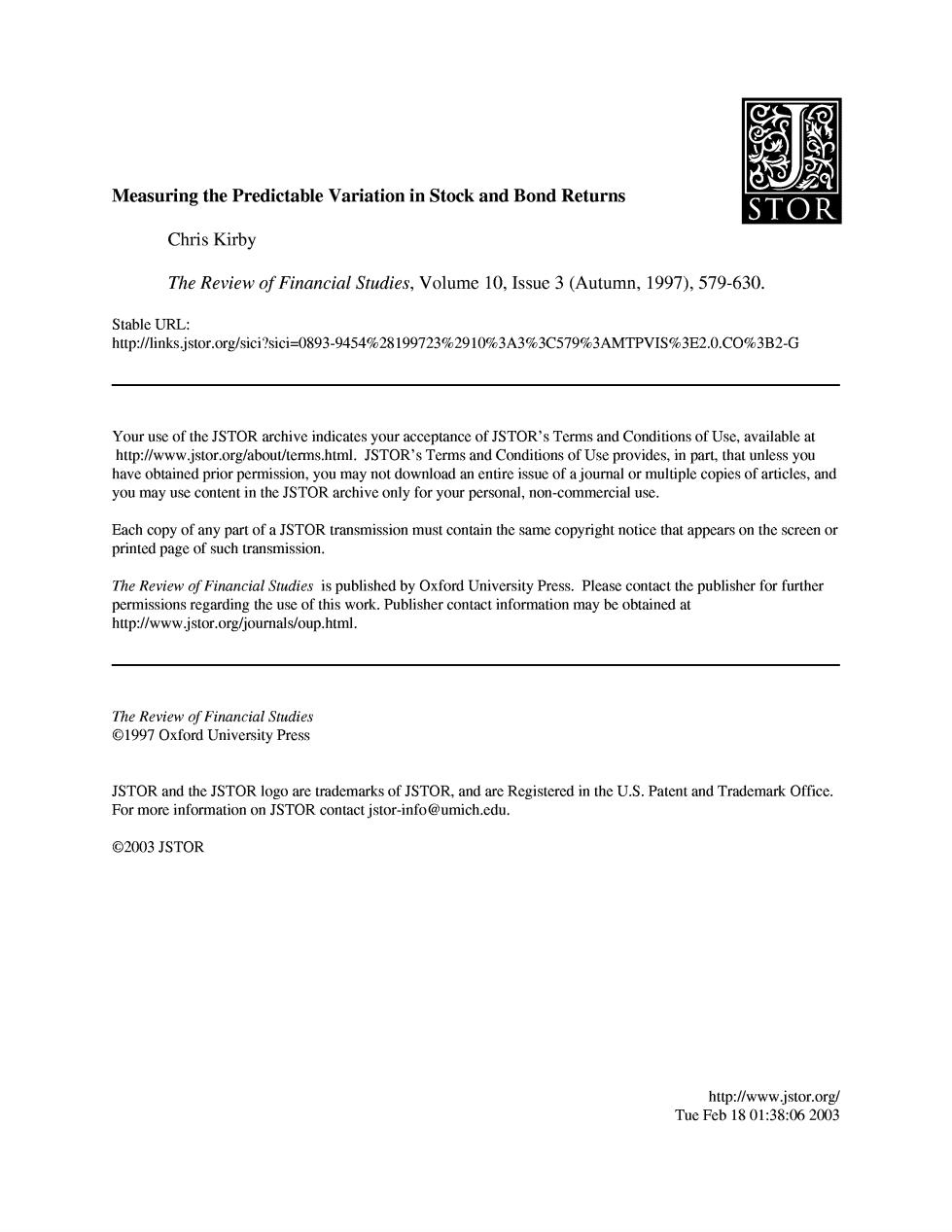
Measuring the Predictable Variation in Stock and Bond Returns T● Chris Kirby The Review of Financial Studies,Volume 10,Issue 3 (Autumn,1997).579-630. Stable URL: http://links.jstor.org/sici?sici=0893-9454%28199723%2910%3A3%3C579%3AMTPVIS%3E2.0.CO%3B2-G Your use of the JSTOR archive indicates your acceptance of JSTOR's Terms and Conditions of Use,available at http://www.jstor.org/about/terms.html.JSTOR's Terms and Conditions of Use provides,in part,that unless you have obtained prior permission,you may not download an entire issue of a journal or multiple copies of articles,and you may use content in the JSTOR archive only for your personal,non-commercial use. Each copy of any part of a JSTOR transmission must contain the same copyright notice that appears on the screen or printed page of such transmission. The Review of Financial Studies is published by Oxford University Press.Please contact the publisher for further permissions regarding the use of this work.Publisher contact information may be obtained at http://www.jstor.org/journals/oup.html. The Review of Financial Studies 1997 Oxford University Press JSTOR and the JSTOR logo are trademarks of JSTOR,and are Registered in the U.S.Patent and Trademark Office. For more information on JSTOR contact jstor-info@umich.edu. ©2003 JSTOR http://www.jstor.org/ Tue Feb1801:38:062003
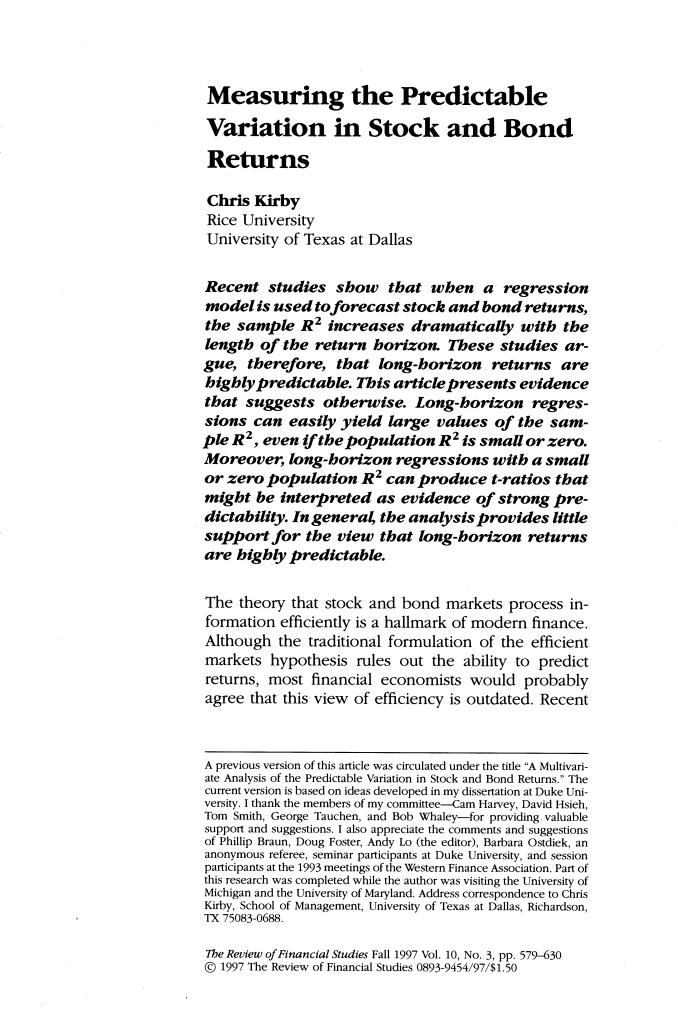
Measuring the Predictable Variation in Stock and Bond Returns Chris Kirby Rice University University of Texas at Dallas Recent studies show that wben a regression model is used to forecast stock and bond returns, the sample R2 increases dramatically with the lengtb of tbe return borizon.Tbese studies ar- gue,tberefore,tbat long-borizon returns are bigbly predictable.Tbis article presents evidence that suggests otberwise.Long-borizon regres- sions can easily yield large values of tbe sam- ple R2,even if the population R2 is smallor zero. Moreover,long-borizon regressions with a small or zero population R2 can produce t-ratios tbat migbt be interpreted as evidence of strong pre- dictability.In general tbe analysis provides little support for the view that long-borizon returns are bigbly predictable. The theory that stock and bond markets process in- formation efficiently is a hallmark of modern finance. Although the traditional formulation of the efficient markets hypothesis rules out the ability to predict returns,most financial economists would probably agree that this view of efficiency is outdated.Recent A previous version of this article was circulated under the title "A Multivari- ate Analysis of the Predictable Variation in Stock and Bond Returns."The current version is based on ideas developed in my dissertation at Duke Uni- versity.I thank the members of my committee-Cam Harvey,David Hsieh, Tom Smith,George Tauchen,and Bob Whaley-for providing valuable support and suggestions.I also appreciate the comments and suggestions of Phillip Braun,Doug Foster,Andy Lo (the editor),Barbara Ostdiek,an anonymous referee,seminar participants at Duke University,and session participants at the 1993 meetings of the Western Finance Association.Part of this research was completed while the author was visiting the University of Michigan and the University of Maryland.Address correspondence to Chris Kirby,School of Management,University of Texas at Dallas,Richardson, TX75083-0688. The Review of Financtal Studies Fall 1997 Vol.10,No.3.pp.579-630 C 1997 The Review of Financial Studies 0893-9454/97/S1.50
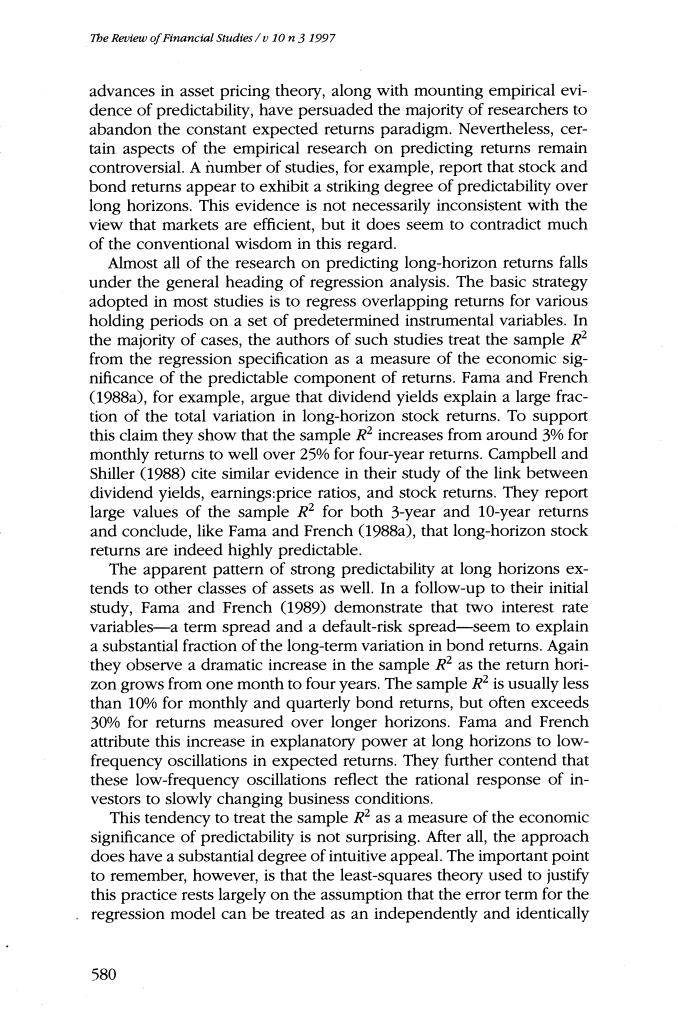
The Review of Financial Studies/v 10n 3 1997 advances in asset pricing theory,along with mounting empirical evi- dence of predictability,have persuaded the majority of researchers to abandon the constant expected returns paradigm.Nevertheless,cer- tain aspects of the empirical research on predicting returns remain controversial.A number of studies,for example,report that stock and bond returns appear to exhibit a striking degree of predictability over long horizons.This evidence is not necessarily inconsistent with the view that markets are efficient,but it does seem to contradict much of the conventional wisdom in this regard. Almost all of the research on predicting long-horizon returns falls under the general heading of regression analysis.The basic strategy adopted in most studies is to regress overlapping returns for various holding periods on a set of predetermined instrumental variables.In the majority of cases,the authors of such studies treat the sample R2 from the regression specification as a measure of the economic sig- nificance of the predictable component of returns.Fama and French (1988a),for example,argue that dividend yields explain a large frac- tion of the total variation in long-horizon stock returns.To support this claim they show that the sample R-increases from around 3%for monthly returns to well over 25%for four-year returns.Campbell and Shiller (1988)cite similar evidence in their study of the link between dividend yields,earnings:price ratios,and stock returns.They report large values of the sample R2 for both 3-year and 10-year returns and conclude,like Fama and French (1988a),that long-horizon stock returns are indeed highly predictable. The apparent pattern of strong predictability at long horizons ex- tends to other classes of assets as well.In a follow-up to their initial study,Fama and French (1989)demonstrate that two interest rate variables-a term spread and a default-risk spread-seem to explain a substantial fraction of the long-term variation in bond returns.Again they observe a dramatic increase in the sample R2 as the return hori- zon grows from one month to four years.The sample R2 is usually less than 10%for monthly and quarterly bond returns,but often exceeds 30%for returns measured over longer horizons.Fama and French attribute this increase in explanatory power at long horizons to low- frequency oscillations in expected returns.They further contend that these low-frequency oscillations reflect the rational response of in- vestors to slowly changing business conditions. This tendency to treat the sample R as a measure of the economic significance of predictability is not surprising.After all,the approach does have a substantial degree of intuitive appeal.The important point to remember,however,is that the least-squares theory used to justify this practice rests largely on the assumption that the error term for the regression model can be treated as an independently and identically 580
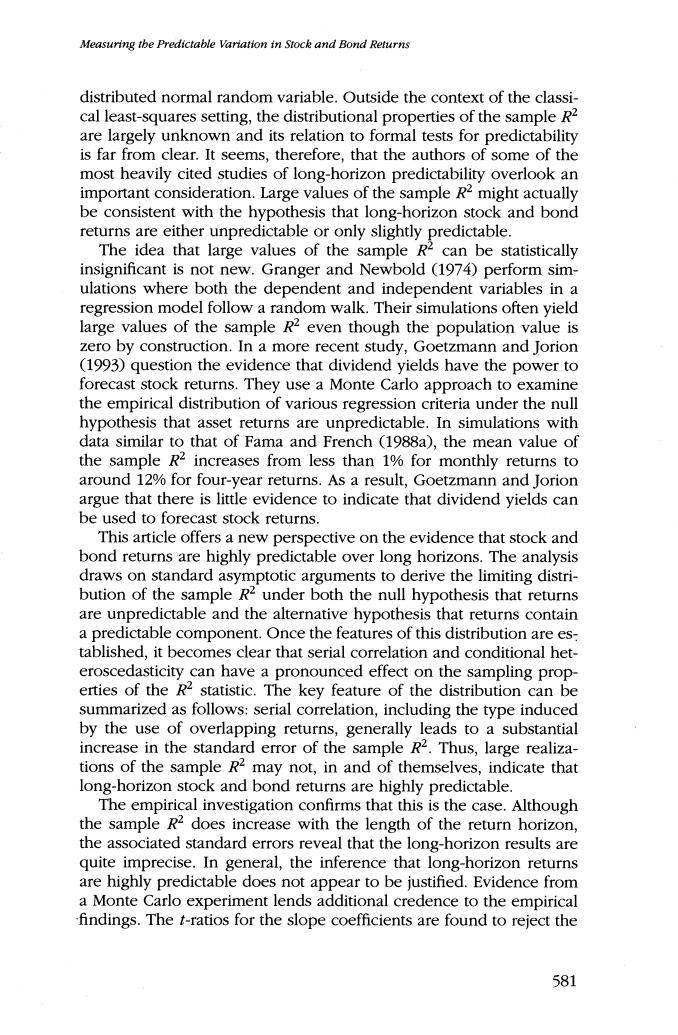
Measuring the Predictable Variation in Stock and Bond Returns distributed normal random variable.Outside the context of the classi- cal least-squares setting,the distributional properties of the sample R2 are largely unknown and its relation to formal tests for predictability is far from clear.It seems,therefore,that the authors of some of the most heavily cited studies of long-horizon predictability overlook an important consideration.Large values of the sample R2might actually be consistent with the hypothesis that long-horizon stock and bond returns are either unpredictable or only slightly predictable. The idea that large values of the sample R can be statistically insignificant is not new.Granger and Newbold(1974)perform sim- ulations where both the dependent and independent variables in a regression model follow a random walk.Their simulations often yield large values of the sample R2 even though the population value is zero by construction.In a more recent study,Goetzmann and Jorion (1993)question the evidence that dividend yields have the power to forecast stock returns.They use a Monte Carlo approach to examine the empirical distribution of various regression criteria under the null hypothesis that asset returns are unpredictable.In simulations with data similar to that of Fama and French (1988a),the mean value of the sample R2 increases from less than 1%for monthly returns to around 12%for four-year returns.As a result,Goetzmann and Jorion argue that there is little evidence to indicate that dividend yields can be used to forecast stock returns. This article offers a new perspective on the evidence that stock and bond returns are highly predictable over long horizons.The analysis draws on standard asymptotic arguments to derive the limiting distri- bution of the sample R under both the null hypothesis that returns are unpredictable and the alternative hypothesis that returns contain a predictable component.Once the features of this distribution are es- tablished,it becomes clear that serial correlation and conditional het- eroscedasticity can have a pronounced effect on the sampling prop- erties of the R2 statistic.The key feature of the distribution can be summarized as follows:serial correlation,including the type induced by the use of overlapping returns,generally leads to a substantial increase in the standard error of the sample R2.Thus,large realiza- tions of the sample R2 may not,in and of themselves,indicate that long-horizon stock and bond returns are highly predictable. The empirical investigation confirms that this is the case.Although the sample R2 does increase with the length of the return horizon, the associated standard errors reveal that the long-horizon results are quite imprecise.In general,the inference that long-horizon returns are highly predictable does not appear to be justified.Evidence from a Monte Carlo experiment lends additional credence to the empirical findings.The t-ratios for the slope coefficients are found to reject the 581
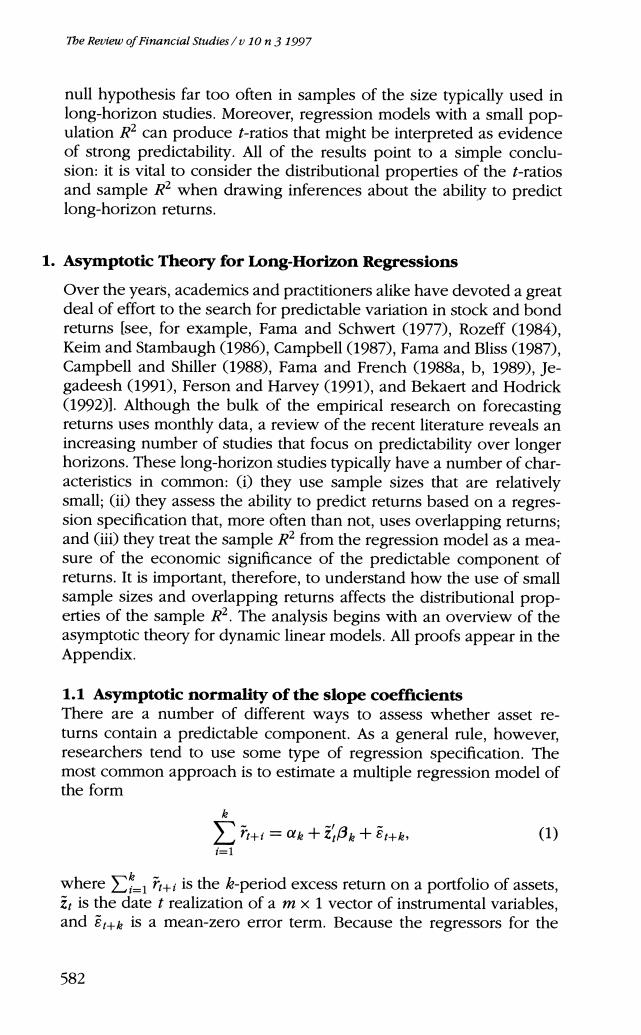
The Review of Financial Studies/v 10 n 3 1997 null hypothesis far too often in samples of the size typically used in long-horizon studies.Moreover,regression models with a small pop- ulation R2can produce t-ratios that might be interpreted as evidence of strong predictability.All of the results point to a simple conclu- sion:it is vital to consider the distributional properties of the t-ratios and sample R2 when drawing inferences about the ability to predict long-horizon returns. 1.Asymptotic Theory for Long-Horizon Regressions Over the years,academics and practitioners alike have devoted a great deal of effort to the search for predictable variation in stock and bond returns [see,for example,Fama and Schwert (1977),Rozeff (1984), Keim and Stambaugh (1986),Campbell (1987),Fama and Bliss(1987), Campbell and Shiller (1988),Fama and French (1988a,b,1989),Je- gadeesh(1991),Ferson and Harvey (1991),and Bekaert and Hodrick (1992)1.Although the bulk of the empirical research on forecasting returns uses monthly data,a review of the recent literature reveals an increasing number of studies that focus on predictability over longer horizons.These long-horizon studies typically have a number of char- acteristics in common:(i)they use sample sizes that are relatively small;(i)they assess the ability to predict returns based on a regres- sion specification that,more often than not,uses overlapping returns; and (iii)they treat the sample R2from the regression model as a mea- sure of the economic significance of the predictable component of returns.It is important,therefore,to understand how the use of small sample sizes and overlapping returns affects the distributional prop- erties of the sample R2.The analysis begins with an overview of the asymptotic theory for dynamic linear models.All proofs appear in the Appendix. 1.1 Asymptotic normality of the slope coefficients There are a number of different ways to assess whether asset re- turns contain a predictable component.As a general rule,however, researchers tend to use some type of regression specification.The most common approach is to estimate a multiple regression model of the form 元+i=十B6十8+k, (1) whereis the -period excess return ona portfolio of assets, E is the date t realization of a m x 1 vector of instrumental variables, and is a mean-zero error term.Because the regressors for the 582